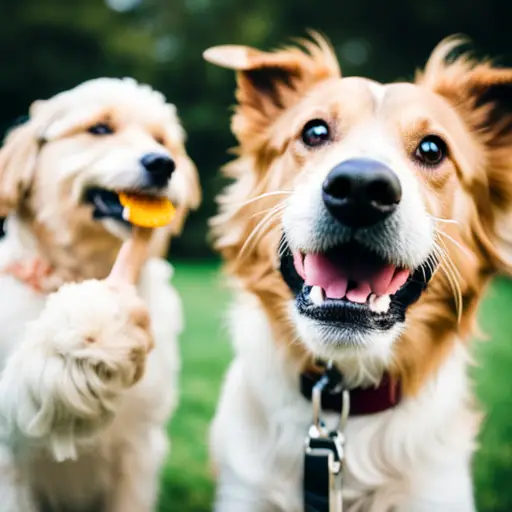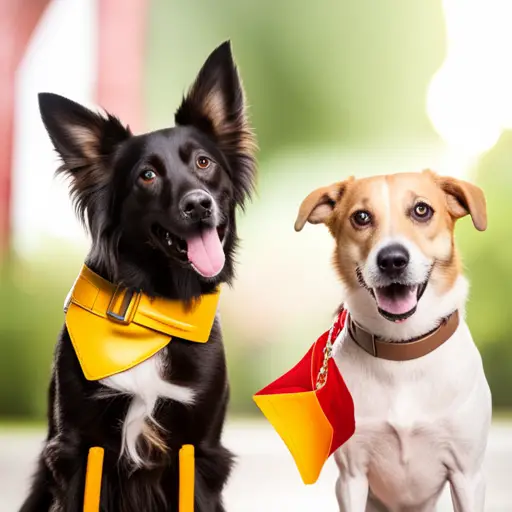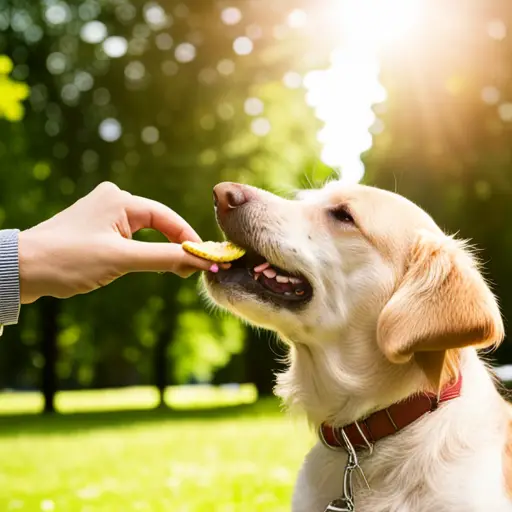Are you a dog owner looking for effective training methods that can help your furry friend become the best version of themselves? Positive reinforcement training is a powerful tool that can help you achieve that goal.
By focusing on rewarding good behavior instead of punishing bad behavior, you can create a strong bond with your dog and help them learn new skills in a fun and engaging way.
In this article, you’ll discover the benefits of positive reinforcement training and how to implement it effectively. You’ll learn about the common mistakes to avoid and get some tips to make your training sessions successful.
With the right approach, positive reinforcement training can transform your dog into a well-behaved, happy, and obedient companion. So, let’s dive in and explore the world of positive reinforcement together!
Key Takeaways
– Positive reinforcement is an effective tool for dog training that rewards desirable behavior with treats, toys, or praise, creating a strong bond between dog and owner and promoting a positive and enjoyable training experience.
– Consistency is crucial, and rewards should be given immediately after the desired behavior using popular techniques such as clicker training, luring, and shaping. Inconsistent rewards and timing can confuse dogs and hinder learning, while punishment can create fear and anxiety, hindering learning and obedience.
– Redirecting negative behaviors is a better approach than punishment, and establishing a consistent training schedule and commands is important. Incorporating playtime into training sessions can keep dogs engaged and motivated, ensuring a fun and rewarding experience for both dog and owner.
– Positive reinforcement is a humane and powerful training tool that can help prevent problem behaviors, build trust between dog and owner, and create a strong, happy relationship between the two. Starting early and being patient and consistent is crucial for success.
Understanding Positive Reinforcement Training

Now, you’re probably wondering how positive reinforcement training works and how it can benefit your furry friend. Positive reinforcement training involves rewarding desirable behavior with treats, toys, or praise, rather than punishing undesirable behavior. This approach is based on the idea that dogs learn best when they’re rewarded for their good behavior, rather than being scolded for their mistakes.
There are different types of rewards that can be used in positive reinforcement training, such as food rewards, play rewards, and affection rewards. The effectiveness of positive reinforcement training has been analyzed in many studies, and it’s been found to be a highly effective method of training.
By using positive reinforcement, you can establish a strong bond with your furry friend and reinforce good behavior. This can help prevent behavior problems and promote a happy, healthy relationship between you and your dog.
With that said, let’s explore the benefits of positive reinforcement training.
Benefits of Positive Reinforcement

Using rewards to encourage good behavior in canines not only fosters a sense of trust and respect between the dog and owner, but also promotes a more positive and enjoyable training experience overall. When you reward your dog for their good behavior, you are tapping into the psychology of rewards. Dogs, like humans, respond positively to rewards and are more likely to repeat behaviors that are associated with positive outcomes. Positive reinforcement training focuses on rewarding good behavior instead of punishing bad behavior, which can create a more harmonious relationship between you and your furry friend.
In contrast, punishment-based training can lead to fear and anxiety in dogs. This can cause them to become aggressive, anxious, or withdrawn, ultimately harming your relationship with them. Positive reinforcement, on the other hand, strengthens your bond with your dog by creating a sense of mutual trust and respect. To illustrate the benefits of positive reinforcement, consider the following table:
| Punishment-based Training | Positive Reinforcement Training |
|---|---|
| —————————– | ——————————- |
| Can lead to fear and anxiety | Creates a sense of trust and respect |
| Can cause aggression | Reduces aggressive behavior |
| Creates a negative experience | Promotes a positive and enjoyable training experience |
By using positive reinforcement, you are not only creating a more positive and enjoyable training experience for your dog, but also strengthening your relationship with them. Now that you understand the benefits of positive reinforcement training, let’s explore how to implement it effectively.
Implementing Positive Reinforcement Training

To effectively implement positive reinforcement training, you need to be consistent with your rewards and timing. This means that you should use the same rewards every time your dog performs a desired behavior.
For example, if you use a treat as a reward, make sure to always use that treat. Additionally, you should reward your dog immediately after they perform the desired behavior. If you wait too long, your dog may not understand what they are being rewarded for.
When it comes to training techniques, there are a few different methods you can use. One popular method is clicker training, where you use a clicker to mark the desired behavior, followed by a reward.
Another method is luring, where you use a treat to guide your dog into the desired position or behavior. Finally, shaping involves rewarding your dog for small steps towards the desired behavior, gradually shaping the behavior until it is fully formed.
Now that you know how to implement positive reinforcement training, it’s important to also be aware of common mistakes to avoid.
Common Mistakes to Avoid

One of the pitfalls to avoid when implementing positive reinforcement training for your dog is being inconsistent with your rewards and timing. It’s important to remember that your dog is learning and needs clear markers for what behaviors are being rewarded. If you’re inconsistent, your dog may become confused and not understand what is expected of them. This can have negative consequences, such as your dog not responding to your commands or even becoming anxious and stressed.
Another common mistake to avoid is using punishment or negative reinforcement in conjunction with positive reinforcement. Punishing your dog can create fear and anxiety, which can hinder their ability to learn and follow commands. Instead, focus on reinforcing positive behaviors and redirecting negative behaviors.
By avoiding these pitfalls, you can create a positive and effective training experience for your furry friend.
Next, let’s explore some tips for successful positive reinforcement training.
Tips for Successful Positive Reinforcement Training

Get ready to unleash your dog’s potential with some simple yet effective tips that will make training a walk in the park! Positive reinforcement is a powerful tool for training dogs, but it’s not always easy to get it right. One of the most important things to keep in mind is consistency. Dogs thrive on routine, so it’s important to establish a consistent training schedule and stick to it. This means training your dog at the same time every day, using the same commands, and rewarding good behavior consistently.
Another important tip for successful positive reinforcement training is to incorporate playtime into your training sessions. Dogs are social animals and they love to play, so incorporating playtime into your training sessions can be a great way to keep your dog engaged and motivated. Use toys or games that your dog loves to play to reinforce good behavior, and make sure to take breaks and have fun during training sessions. Remember, positive reinforcement should be a fun and rewarding experience for both you and your dog!
| Consistency | Incorporating Playtime |
|---|---|
| ————- | ———————— |
| Establish a consistent training schedule | Use toys or games that your dog loves to play to reinforce good behavior |
| Use the same commands consistently | Take breaks and have fun during training sessions |
| Reward good behavior consistently | Incorporate playtime into your training sessions |
| Dogs thrive on routine | Positive reinforcement should be a fun and rewarding experience for both you and your dog |
By following these simple tips and incorporating consistency and playtime into your positive reinforcement training, you’ll be well on your way to unlocking your dog’s full potential. Remember, training your dog is not only a way to improve their behavior, but it’s also a great way to deepen the bond between you and your furry friend. Keep things fun, consistent, and positive, and you and your dog will be unstoppable!
Conclusion
So there you have it – positive reinforcement training is a powerful tool for training your furry friend. By rewarding good behavior, you can effectively shape your dog’s behavior and build a strong bond with them at the same time.
One example of positive reinforcement training in action is with a dog who has a habit of jumping up on guests. Instead of scolding the dog, the owner could use positive reinforcement by rewarding the dog with treats and affection when they keep all four paws on the ground. Over time, the dog will learn that good things happen when they don’t jump up, and the unwanted behavior will slowly disappear.
Remember to be patient and consistent, and you and your dog will reap the benefits of positive reinforcement training.
